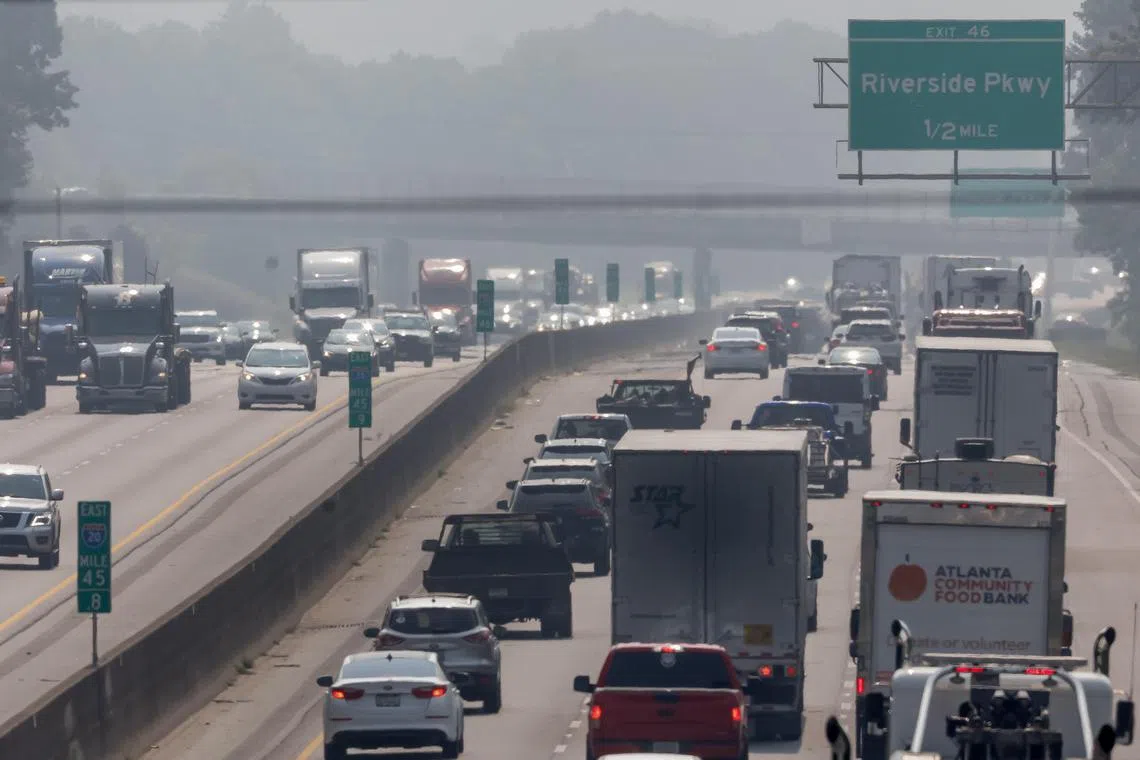Canadian wildfire smoke reaches new areas in the southern US
Sign up now: Get ST's newsletters delivered to your inbox

Commuters negotiating the hazy conditions during the morning rush hour traffic along a highway in Atlanta, Georgia.
PHOTO: EPA-EFE
Follow topic:
NEW YORK – Smoke from wildfires in Canada that pushed deep into the United States this week
“Horrific up here!” Ms Merry Miller Weis, a 70-year-old resident in the Western North Carolina mountains, wrote in an e-mail to state climate scientists. “The mountains aren’t even visible. This is the absolute worst since the beginning of the Canadian fires.”
In June, heavy smoke from fires in the Canadian province of Quebec wafted towards the East Coast, enveloped parts of New York and moved through other states, past Washington, DC, and as far west as Minnesota.
In July, the vast plume has wafted in from fires in Canada’s north-west, smothering the skies and raising warnings about the impact on health.
Mr Corey Davis, an assistant state climatologist in North Carolina, said in an interview on Tuesday that his office had received the unsolicited e-mail from Jackson County, a part of the state that was new territory for smoke attributed to the Canadian wildfires to linger.
In June, it appeared mostly in the north-central urban region known as the Triad, anchored by the cities of Greensboro, Winston-Salem, and High Point.
“It is now more concentrated in the West,” Mr Davis said. “We have a high pressure system parked over the western part of the state. It’s like putting a lid on a pot of boiling water. Smoke mainly from the western Canadian wildfires is basically trapped right at the ground level.”
Around 8am on Tuesday, more than 44 million people in 28 states and Washington, DC continued to be affected by smoke from the fires, and many states in the South are under heat advisories, including parts of Georgia and Tennessee.
In Greensboro, a reading of the air quality index was in the range of 152 early on Tuesday, and in Atlanta, the index measured 150 by noon, both unhealthy levels.
Mr Davis, describing the sky in Raleigh as a “pale orange, completely blank canvas”, said the state’s western region “may be a little bit worse than what we had last month”.
He said the state was at “Code Orange” – meaning an unhealthy air quality for sensitive groups – for four days in June, “the most in 11 years”.
In Georgia, smoke infiltrated the sky over more communities in Atlanta and along the border with Tennessee, and for the first time in Athens, said Mr Jim Boylan, the chief of the air protection branch at Georgia’s Environmental Protection Division.
That data was based on readings of particulate matter from seven monitors: five around Atlanta, one in Rossville and one in Athens, he said. All were Code Orange on the air quality index, which means unhealthy for sensitive groups. In June, four monitors picked up those readings.
“This time we have more locations than last time,” he said.
Several factors propelled the smoke towards the South, said Mr Bill Murphey, the state climatologist in Georgia. Winds helped to funnel it farther into the South, compared with previous smoke intrusions, he said.
“This push of smoke is a little bit higher up in the atmosphere, kind of vertically stacked, than the previous one,” he said. There was also a higher concentration of particle pollution, he said.
In South Carolina, sensors have picked up higher concentrations of particulate matter than seen previously, said Mr Andrew Kingston, the lead meteorologist for the state bureau of air quality. A recent lack of wind flow east of the Appalachians has meant the smoke “just sits there and doesn’t disperse”, he said.
“The weather pattern is perfect for sending it further south,” he said. “The last time it kind of touched us. But this time it is aimed directly at us.”
Over the past few days, government officials in several states have advised residents to curtail their outdoor activity and, in some cases, to wear a mask.
Ms Weis, who wrote the e-mail to the North Carolina climate office, said she wore one on a trip to the post office on Monday, but she said her “eyes and throat feel as if they’re on fire”.
Reached by telephone, she said the smoke had settled below the treeline in the mountains where she lives in the region of Cullowhee, obscuring her view of the Blue Ridge Mountains and Mount Pisgah, about 64km away as the crow flies.
“Usually, it is a spectacular view,” she said. “But they have just disappeared.” NYTIMES

